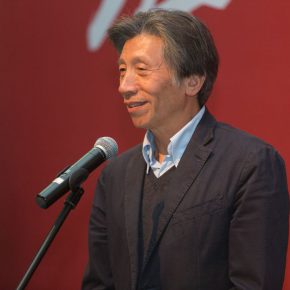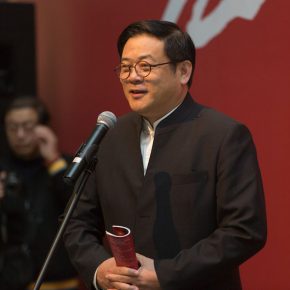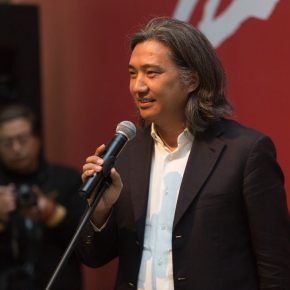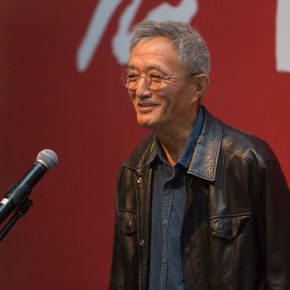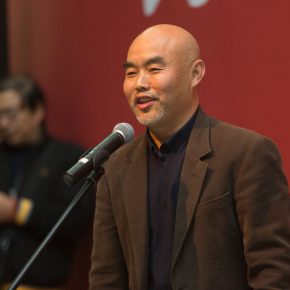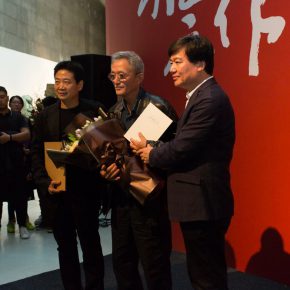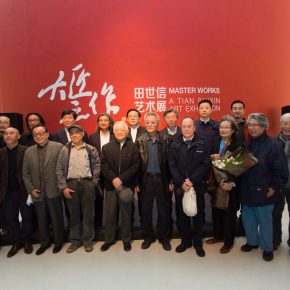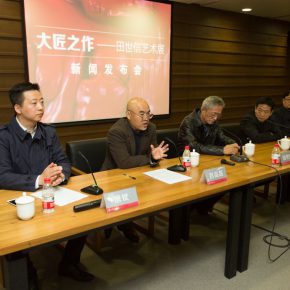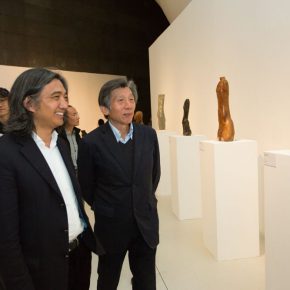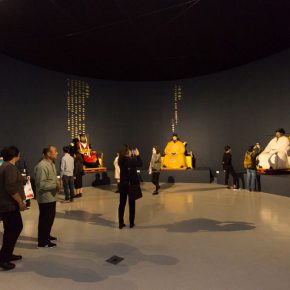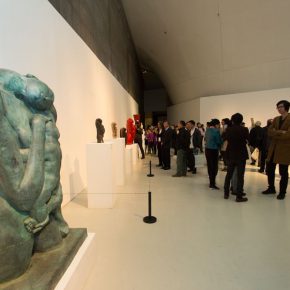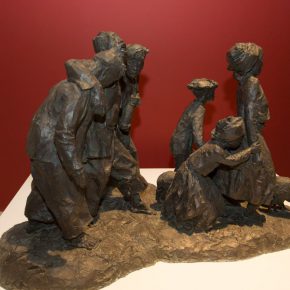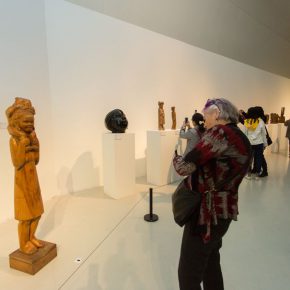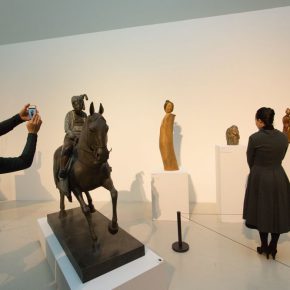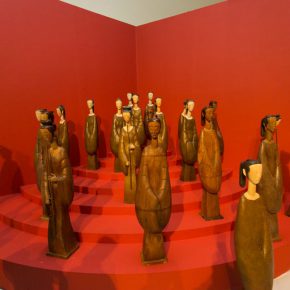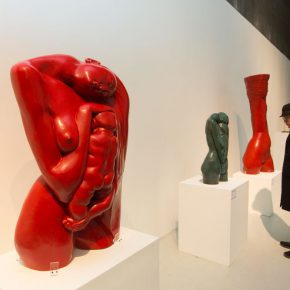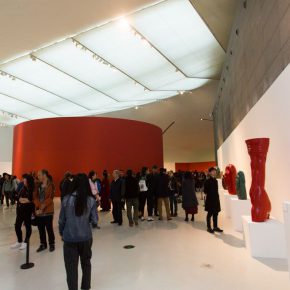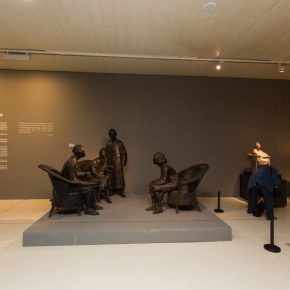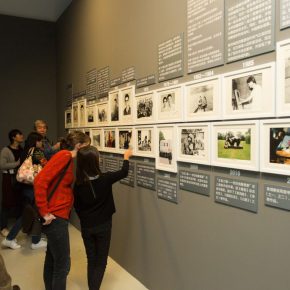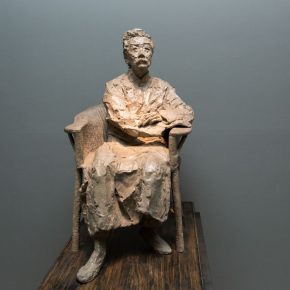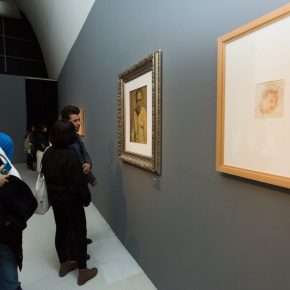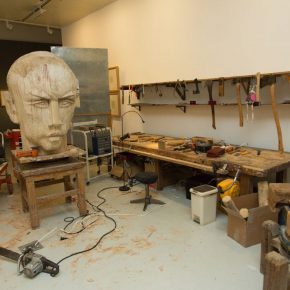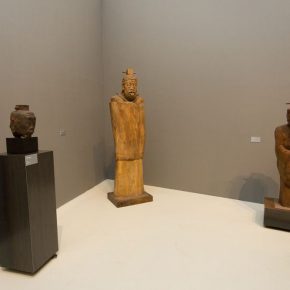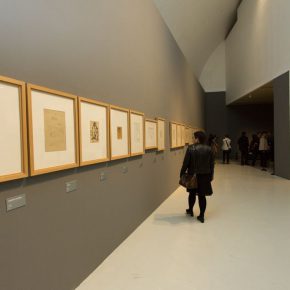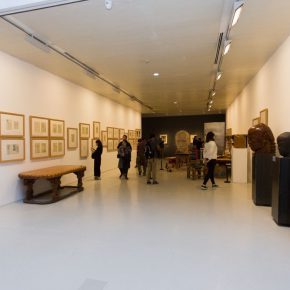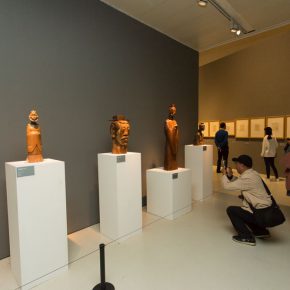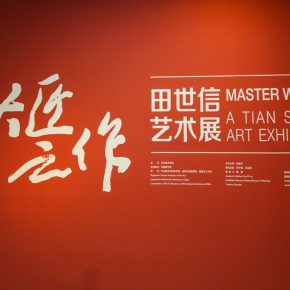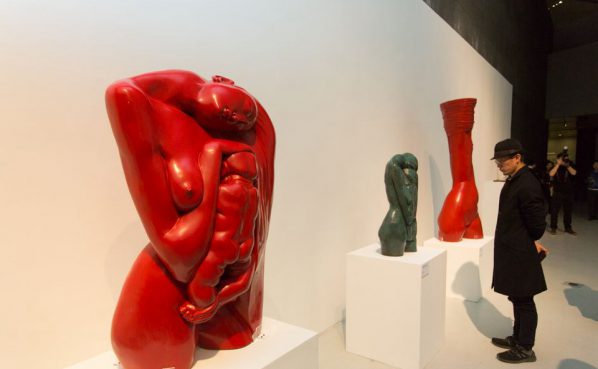
On October 13, 2017, hosted by CAFA, “Master Works – A Tian Shixin Art Exhibition” opened in the exhibition hall of 3F of the CAFA Art Museum. It is for the research and evidence of the art creation by Tian Shixin in the last over 60 years, to showcase the representative works by the artist in various historical periods, showing the artist’s insistence on the traditional sculptural creation and reflection on the new form of contemporary sculpture, as well as a concern with local customs, especially the observation of the spirit of the mountain villagers of the minority groups and the deep humanistic feelings.
Tian Shixin is one of the key figures who plays the role of the connecting link in the development of modern and contemporary Chinese sculpture. He graduated from the Beijing Institute of Arts 1964 and volunteered to be assigned to the remote mountainous area of Guizhou. After 25 years, he was transferred to the Institute of Sculpture at CAFA. He was a former member of the council of the China Artists Association and Deputy Director of the Sculptural Art Committee at China Artists Association, now he is a professor at CAFA, a Distinguished Professor of the Institute of Sculpture at the China National Academy of Arts, a consultant of the National Urban Sculpture Construction Steering Committee. Tian Shixin has been engaged in sculptural creation for more than 60 years, and he also influenced a large number of sculptural artists, such as Xiang Jing, Qu Guangci, Chen Wenling, Cai Zhisong and so on.
This is a retrospective academic research exhibition of Tian Shixin’s work, which fulfills a long held wish of both teachers & students from CAFA, and the circles of sculptural art. Gao Hong, Party Secretary of CAFA, Fan Di’an, President of CAFA, Su Xinping, Vice President, Zhang Zikang, Director of CAFA Art Museum, Ma Lu, Dean of the School of Plastic Arts, Zhang Lujiang, Deputy Dean of the School of Plastic Arts, Wang Zhong, Dean of the School of Urban Design, Yu Ding, Institute of Arts Administration and Education, Xu Li, Party Secretary of China Artists Association and Executive Vice Chairman, Wu Weishan, Director of National Art Museum of China, the senior Prof. Sheng Yang, Du Jian, Wang Hongjian, Sun Jiabo, Sun Jingbo, Zhang Baowei, Qiu Zhenzhong, Sui Jianguo, Cao Chunsheng, artist Tian Shixin, and the curator of the exhibition Tang Bin attended the opening ceremony. Lv Pinchang, Deputy Dean of the School of Plastic Arts, CAFA, and Director of the Department of Sculpture hosted the opening ceremony.
Fan Di’an, President of CAFA, delivered a speech at the opening ceremony, and he talked about the three dimensions including the college education, life and times as well as introducing where the art of Tian Shixin came from. At the same time, Fan said that Tian Shixin was both based in the country and explored tradition, blended the majestic power of sculptures of the Qin & Han Dynasties and the ethereal & magnificent expression of Hunan culture, to present a personal face of art that shows the harmony between “quality” and “text”. He also talked about Tian Shixin’s exploration of a variety of materials, for example, the wood carvings maintenance of the veins & texture of the material, maintenance of the carving marks created by a fat axe, with a clumsy form; from clay to bronze creations, he emphasizes the sense of the touch of hands and the marks; the traditional lacquer is applied in the sculpture, then developed to a new art topic, expanding the sculptural formal language, making a contribution to the contemporary development of Chinese sculptures.
The exhibition is divided into five parts: Han’s Style and Tang’s Charm, Folk Sculptures, Respected Kings, Contemporary Vision, Respecting Culture and Scholars and also presents a series of drawings, sketches, oil paintings and manuscripts as well as documents. Tian Shixin was assigned to the Qingzhen middle school in Guizhou after graduation in 1964, where he taught & lived for 25 years, and also began his early creation. The working people’s spirit of working hard in difficult conditions in the mountain area became the creative theme and he created a large number of distinctive sculptural images of mountain villagers, which are of a national folk and local creative form, being dignified and unpolished, to become a true portrayal of the passion of mountain people’s life. He has transcended the feelings of “sketch” of folk custom of the Chinese sculpture, to express a heavy, mysterious and stirring state, which is the artist’s insight to the life of people in the real world.
After he returned to Beijing, Tian Shixin’s creation began to explore the inheritance and transformation of traditional culture and spirit, and the works penetrated into the humanities. Tian Shixin preferred the line drawing of traditional Chinese painting, and he has created a number of works of women by transforming the language of line drawing to be three-dimensional, either the slender “Woman of Hang” or the fat “Woman of Tang Dynasty”, they both reflect the highly summarized spirit and temperament of a specific era. In addition to ladies, Tian Shixin was also keen to show the historical figures, especially the tragic historical roles, and he was in pursuit of a noble beauty and tragic sense in the aesthetics. From the “Portrait of Lao Zi”, “Sima Qian”, “Qu Yuan” to “Tan Sitong” and “Lu Xun”, Tian Shixin used a simple oriental rule of shaping to convey his self-identity of the spirit and attitude of life of the historical figures. As the artist said, these historical figures had a commonality so these people were extremely responsible for the “human”. In 1993, when Tian Shixin saw the portrait of Zhao Kuangyin at the Palace Museum in Taipei, he began to pay attention to the statues of the ancient emperors. He borrowed the depiction of Mao Zedong’s “Qinyuanchun · Snow”, to transform the language of line drawing to be three-dimensional through the form of sculpture, to shape the images of five kings including “First Emperor of Qin”, “Emperor Wu of Han”, “Emperor Taizong of Tang”, “Emperor Taizu of Song”, “Genghis Khan”, to express the theme of “dialogue with ancient people”, hoping to bring people spiritual guidance. The work of “Respected Kings” is a new beginning of Tian Shixin’s artistic career in the creation, and the milestone works of modernism transform the conceptualism or contemporary.
The part of “Contemporary Vision” presents the artist’s exploration of real life and contemporary art, as well as his special interest in materials and things that he attempted to expand. “When faced with the characteristics and beauty of different materials, I can’t help but figure out some interesting things, I would like to think tangible things from the intangible. From the early days when Tian was in Guizhou, he saw the local farmers used lacquer and leather to produce daily necessities, which started with his basic understanding of the process of lacquer, he later visited the unearthed cultural relics of Mawangdui tomb of Han Dynasty, where he found that the lacquer still remained as of a bright and magnificent appearance after thousands of years, so he began to try to use the lacquer in the field of sculpture, opening a new development in lacquer sculptures.
Tian Shixin has created a self-fermentation, self-consciousness, self-improvement in the field of sculpture, through a variety of explorations of themes, materials, and methods, thus creating the unity of force and beauty, the appearance and quality, by the “artisan” labor in the creative process. At the opening ceremony of the exhibition, Tian Shixin donated the large-scale group sculptures entitled the “Flower Bridge” to CAFA, to support the collection of the country. The exhibition remains on view till October 29.
Text by Zhang Wenzhi, Photo by Yang Yanyuan/CAFA ART INFO
Translated by Chen Peihua and edited by Sue/CAFA ART INFO


